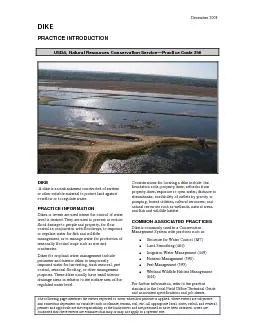

December 2008 USDA Natural Resources Conservation Service151Practice Code 356 A dike is an embankment constructed of earthen or other suitable material to protect land against overflow or to re ID: 853926
Download Pdf The PPT/PDF document "PRACTICE INTRODUCTION" is the property of its rightful owner. Permission is granted to download and print the materials on this web site for personal, non-commercial use only, and to display it on your personal computer provided you do not modify the materials and that you retain all copyright notices contained in the materials. By downloading content from our website, you accept the terms of this agreement.
1 December 2008 PRACTICE INTRODUCTION US
December 2008 PRACTICE INTRODUCTION USDA, Natural Resources Conservation Service—Practice Code 356 A dike is an embankment constructed of earthen or other suitable material to protect land against overflow or to regulate water. PRACTICE INFORMATION Dikes or levees are used where the control of water permits and approvals are the responsibility of the landowners and are presumed to have been obtained. Users are cautioned that these effects are estimates that may or may not apply to a specific site. Initial setting: Cropland on which retention and management of water is needed and construction of small, hazard class III dike(s) will achieve the following purposes: (1) production of crops requiring seasonal flooding; or (2) creation of small moist soil units to benefit wildlife The diagram above identifies the effects expected to occur when this practice is applied according to NRCS practice standards and specifications. These effects are C.1 (+/-) Income and income stability (individuals and community) 1. Earthen embankment, D.1 (-) Acres of cropland and/or wetland (dike Notes Effects are qualified with a plus (+) or minus (-). These symbols indicate only an increase (+) or a decrease (-) in the effect upon the resource, not whether the effect is beneficial or adverse. The scope of the practice implementation and resulting effects are limited to those described in the “initial setting.” Construction of dikes for other
2 purposes, in floodplains, marshes, estu
purposes, in floodplains, marshes, estuaries, or other sensitive areas or where a hazard class of I or II applies may need to be evaluated in a site-specific EA. Structure for Water Control ( 587 ) D.3 (-) Fish D.6 (+) Water D.7 (+) Water I.1 (-) Cropland and wetland Freshwater and I.3 (-) Wetland wildlife habitat C.2 (+/-) Biodiversity I.11 (+/-) Quality of receiving waters Water I.13 (+) Crop vigor (target crop) D.8 (+) Cost of and maintenance (O&M) D.4 (+) Water depth (seasonal) I.6 (+) Habitat for shoreline, wading and shallow water wildlife Wetland wildlife 2. Closed agricultural water use system I.15 (+/-) Net return I.14 (+) Potential income I.2 (-) Crop LEGEND #. Created by practice D. Direct effect I. Indirect effect C. Cumulative effect Pathway ( + ) increase; ( - ) decrease Associated p ractice Start D.2 (-) fresh/saltwater wetland, and/or D.5 (-) River-interactions (extent, I.10 (+) Bank erosion complexity I.12 (-) to downstream I.9 (+) O&M activities community) subjective and somewhat dependent on variables such as climate, terrain, soil, etc. All appropriate local, State, Tribal, and Federal permits and approvals are the responsibility of the landowners and are presumed to have been obtained. All income changes are partially dependent upon market fluctuations which are independent of the conservation practices. Users are cautioned that these effects are estimates that may or may not apply to a specific site